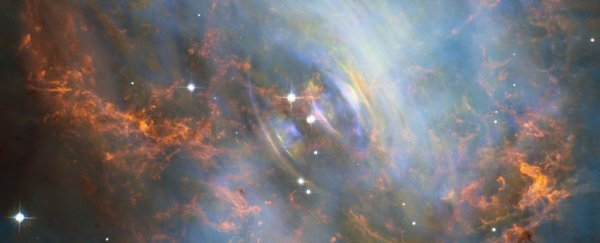Summary: Extreme pulsars may emit radiation in more ways than we think
Radio pulsars may erupt into space with far more radiation than we think.

Figure 1 Crab Cloud Pulsar (Source: NASA/ESA; J. Hester/ASU and M. Weisskopf/NASA/MSFC)
A new study of Crab Cloud pulsars 6,500 light-years away from us suggests that the occurrence of a phenomenon called "giant radio pulses" increases with X-ray emission.
This means that these phenomena are far more active than we think, and at the same time, it also confirms that the mysterious rapid radio bursts (FRBs) emitted from interstellar space millions of light-years away do exist.
A radio pulsar is a mysterious type of star. They are dense objects made up of neutron stars (neutron stars: dense cores of massive stars that collapse after supernova explosions).
Figure 2 Crab cloud pulsar (Source: NASA, ESA, and J. Hester)
Many neutron stars are simply inconspicuously hidden in the universe, but pulsars are more easily observed by humans because they can constantly emit electromagnetic pulses. Pulsars rotate very fast and emit streams of electromagnetic pulses from their north and south poles; so that when these pulsars rotate across the Earth, we can see them disappearing, like a beacon of milliseconds flickering rapidly in the universe.
But not all pulsars are the same. Some pulsars will have millisecond electromagnetic pulses in a very short period of time that are greater than the normal radiation intensity of the Death Star.
Located at the center of the magnificent Crab Nebula, the Crab Cloud Pulsar was born from a supernova explosion less than 1,000 years ago. At the same time, it is also one of the youngest pulsars we have found, with a rotation period of 33ms, or 30 rotations per second.
It is also a prolific giant pulsar, the only object known to us with a wavelength greater than radio wavelength. When a crab cloud pulsar erupts, the intensity of visible light increases accordingly.
Because of this, an international team of astronomers, led by Akiyoshi Yukito of the Riken Cluster Frontier Research Institute in Japan, is looking for other wavelengths. Members from around the world used radio and X-ray telescopes to observe Crab Cloud pulsars simultaneously to see if they could detect an increase in X-ray emission in the huge radio pulses.
After three years, they finally detected a signal that was obvious and clear enough to confirm that the Crab Cloud Pulsar did indeed emit about 4 percent of the X-rays in its massive radio pulses, further suggesting that we were greatly underestimating the energy in it.
Figure 3 Left: Supernova explosion wreckage Right: Simulation model (Crab pulsar) (Source: NASA/CXC)
"Our observations prove that the energy of these huge pulses is hundreds of times stronger than we previously thought," said Akiyoshi Yukio.
We don't actually know the cause of these huge radio pulses, so it's a very interesting piece of information. The researchers said that this 4 percent increase is consistent with the increase in optical radiation, suggesting that high-energy radiation has the same spectral energy distribution as ordinary pulses. This puts some limitations on the factors we believe may be contributing to the pulsation of radiation from this star.
The team also found that the results they observed were consistent with magnetic reconnection (magnetic reconnection: the release of energy produced when magnetic field lines around stars break and reconnect). This is a fact that has always existed around the sun and is the cause of solar flares.
Giant radio pulses are also thought to be mysterious electrical signals from other galaxies in a low-energy way, also known as fast radio bursts. Similar to giant radio pulses, almost all fast radio bursts are random and last only a few milliseconds, but they come from farther away in the universe and are therefore more energetic.
Last year, astronomers first detected a rapid ray burst from the solar system, the source of which was a magnetar star (magnetar: a neutron star with a very strong magnetic field). Even more surprising is that there is little cross between pulsars and magnetism, and some astronomy therefore believes that magnetars evolved from pulsars.
Figure 4 X-rays of a magnetar (from NASA's Goddard Space Flight Center)
There may be more than one mechanism for generating fast radio bursts, so this remains a mystery. But the study offers a new idea: Some fast radio bursts will repeat themselves — if they are produced by a mechanism similar to a giant radio pulse, then the stars will quickly darken so that we can repeat observations in at least one source of fast radio bursts.
So we can now know that there are other mechanisms behind at least some fast radio bursts — but we can't completely eliminate the possibility of pulsars. "This is still controversial, but the facts we have discovered and the upcoming discoveries about fast radio bursts have helped us understand the relationship between these phenomena," said Akiyoshi Yukio. ”
Maybe we don't understand, but we will definitely ask the mystery of space to break the casserole to the end.
The team's findings have been published in the journal Science.
BY: MICHELLE STARR
FY: Happy and happy for 10,000 years
If there is any infringement of the relevant content, please contact the author to delete it after the work is published
Please also obtain authorization to reprint, and pay attention to maintaining completeness and indicating source